初中八年级英语说课稿
人教版8年级初中英语说课稿(共5篇)
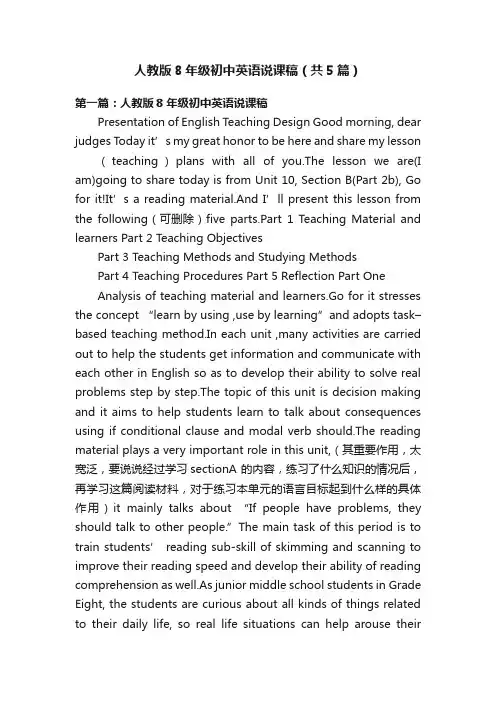
人教版8年级初中英语说课稿(共5篇)第一篇:人教版8年级初中英语说课稿Presentation of English Teaching Design Good morning, dear judges Today it’s my great honor to be here and share my lesson (teaching)plans with all of you.The lesson we are(I am)going to share today is from Unit 10, Section B(Part 2b), Go for it!It’s a reading material.And I’ll present this lesson from the following(可删除)five parts.Part 1 Teaching Material and learners Part 2 Teaching ObjectivesPart 3 Teaching Methods and Studying MethodsPart 4 Teaching Procedures Part 5 Reflection Part OneAnalysis of teaching material and learners.Go for it stresses the concept “learn by using ,use by learning”and adopts task–based teaching method.In each unit ,many activities are carried out to help the students get information and communicate with each other in English so as to develop their ability to solve real problems step by step.The topic of this unit is decision making and it aims to help students learn to talk about consequences using if conditional clause and modal verb should.The reading material plays a very important role in this unit,(其重要作用,太宽泛,要说说经过学习sectionA 的内容,练习了什么知识的情况后,再学习这篇阅读材料,对于练习本单元的语言目标起到什么样的具体作用)it mainly talks about “If people have problem s, they should talk to other people.”The main task of this period is to train students’ reading sub-skill of skimming and scanning to improve their reading speed and develop their ability of reading comprehension as well.As junior middle school students in Grade Eight, the students are curious about all kinds of things related to their daily life, so real life situations can help arouse theirinterest and enthusiasm.(此处学生对各种事物的好奇,可具体到学生的实际生活,会遇到各种困惑的问题那么通过本课课文的阅读可以给他们带来什么实际意义)Part Two Teaching ObjectivesAccording to the analysis above, I set the following teaching objectives: First, knowledge aims.The students will(will be able to use)use the following expressions properly: teenager;expert, unless, careless, careful experience, keep…to oneself, in half etc.and understand some important sentences such as “Unless we talk to someone, we’ll certainly feel worse.” “So you’re halfway to solving a problem just by talking to someone about it.”Second, ability aims.By the end of the class, the students will be able to skim(skim for the general idea)and scan for the specific information form the passage.Third, emotional aims.During the class, students’ cousciousness of sharing problems with others will be inspired.Among these points, I think the useful expressions and improvement of reading ability are the key and difficult teaching points.Part 3 Teaching Methods and Studying Methods According to modern teaching theories and the new curriculum standards, I will adopt task-based language teaching method, I will set the following activities such as : individual work , pair work and group work to achieve the teaching goals.(In order to achieve the teaching goals , the following activities such as : individual work , pair work and group work will be used)I will try my best to make students the real masters of the class, while teachers only as directors.(Independent study method)and the students will learn in a relaxing atmosphere by reading, speaking, thinking and discussing in groups.(Cooperation study method) And I’ll use the blackboard and the multi-media during myteaching.Part 4 Teaching Procedures To achieve the objectives above, I design several activities with the aid of PPT.The teaching procedures will follow PWP model(pre-reading,while-reading and post-reading).Step 1 Greetings T o begin the class, I’ll greet my students as usual.Step 2 Pre-readingI will lead in this lesson by showing the students a video(it is about a quarrel between my student and her best friend).In this video, the students will hear some new words for the first time, such as unless, angry, understanding.Then I will try to get advice from the students(possible answers: say sorry to her friend, give her a gift…..)After that I will show a photo of myself and tell them after talking to me, she feels better now.Then we can go into the topic of this lesson “If people have problems, they should talk to other people.”(The topic related to the students’ daily life closely, so they should be glad to disscuss it with me.) Step 3 while-reading During the while-reading process, I will design some activities for them to understand the passage better.Activity(可否换为task?)One: In order to improve their reading sub-skill of skimming, I’ll ask them to read the whole passage as quickly as possible and find out the answer to the following question: There are two persons(添加who)agree with the idea “If people have problems, they should talk to other people.” Who are they?(Through the question, students will get the main idea of this passage more clearly).Activity Two: In order to improve their reading sub-skill of scanning.The students will be asked to read Paragraph 1-2 and find some details about Laura.(They should use scanning----a process of searching for specific information.Here I’ll explain it to them first.)And during the activity, I want to show the difference between “careful” and “careless”(Let the students know something about theword-building, such as “home” and “homeless”, “help” and “helpless”….此处提出 ful,less 是两个相反的后缀,了解了这两个后缀对解决生词有很大帮助)Activity Three: Read Paragraph 3 and Tell T or F about Robert Hunt.(换换说法:check if some statements about Hunt are ture or false)(The students will practice the scanning skill again.)★(The answers to Activity Two and Three will use the key words and expressions in this lesson)★(这句话貌似Chinglish)★(The students will work in pairs or groups to finish Activity Two and Three)★Activity Four: I will ask the students to read the whole article (passage)again and raise questions to each other.(In this way, the students will be encouraged to think on their own.This can also give them a chance to share problems with other students).(任务不具体)Step 4 Post-reading After the students finish the reading, I’ll prepare an open-ended(是不是 open-minded?)activitiy.The students work in groups of 4 and talk about their own problems first, then they could write a short letter for(to)each other, in order to solve the problems.Then it’s sharing time!(They should know helping others is a good thing.)(step4 开放性问题和step3 中的活动四似乎有点重复,单纯的说看不出多少文章的升华和学以致用。
八年级英语上册-人教版-Unit 5 说课稿
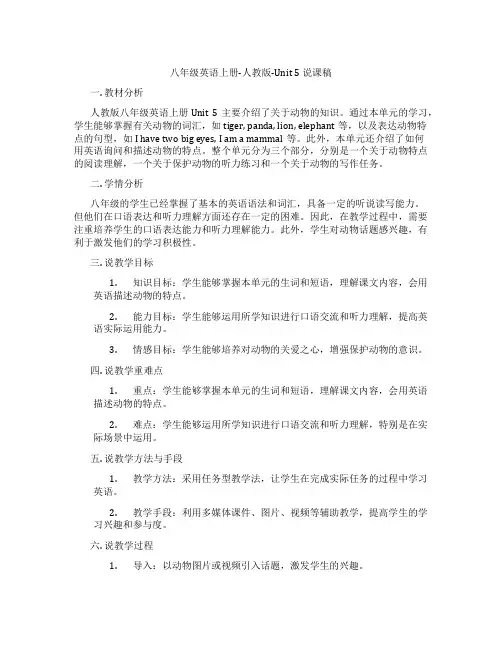
八年级英语上册-人教版-Unit 5 说课稿一. 教材分析人教版八年级英语上册Unit 5主要介绍了关于动物的知识。
通过本单元的学习,学生能够掌握有关动物的词汇,如tiger, panda, lion, elephant等,以及表达动物特点的句型,如I have two big eyes, I am a mammal等。
此外,本单元还介绍了如何用英语询问和描述动物的特点。
整个单元分为三个部分,分别是一个关于动物特点的阅读理解,一个关于保护动物的听力练习和一个关于动物的写作任务。
二. 学情分析八年级的学生已经掌握了基本的英语语法和词汇,具备一定的听说读写能力。
但他们在口语表达和听力理解方面还存在一定的困难。
因此,在教学过程中,需要注重培养学生的口语表达能力和听力理解能力。
此外,学生对动物话题感兴趣,有利于激发他们的学习积极性。
三. 说教学目标1.知识目标:学生能够掌握本单元的生词和短语,理解课文内容,会用英语描述动物的特点。
2.能力目标:学生能够运用所学知识进行口语交流和听力理解,提高英语实际运用能力。
3.情感目标:学生能够培养对动物的关爱之心,增强保护动物的意识。
四. 说教学重难点1.重点:学生能够掌握本单元的生词和短语,理解课文内容,会用英语描述动物的特点。
2.难点:学生能够运用所学知识进行口语交流和听力理解,特别是在实际场景中运用。
五. 说教学方法与手段1.教学方法:采用任务型教学法,让学生在完成实际任务的过程中学习英语。
2.教学手段:利用多媒体课件、图片、视频等辅助教学,提高学生的学习兴趣和参与度。
六. 说教学过程1.导入:以动物图片或视频引入话题,激发学生的兴趣。
2.呈现:展示本课的生词和短语,让学生朗读并理解含义。
3.讲解:讲解课文内容,让学生理解动物的特点和保护动物的重要性。
4.练习:进行口语练习,让学生用英语描述动物的特点。
5.听力:播放听力材料,让学生回答相关问题。
6.输出:让学生写一篇关于保护动物的短文。
初二英语全英文说课稿
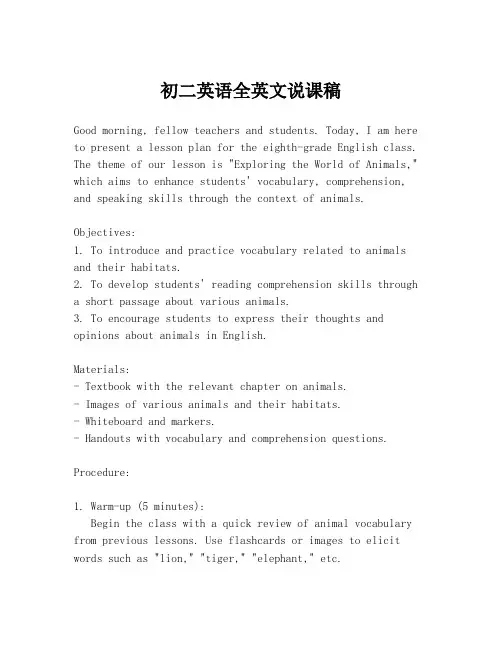
初二英语全英文说课稿Good morning, fellow teachers and students. Today, I am here to present a lesson plan for the eighth-grade English class. The theme of our lesson is "Exploring the World of Animals," which aims to enhance students' vocabulary, comprehension, and speaking skills through the context of animals.Objectives:1. To introduce and practice vocabulary related to animals and their habitats.2. To develop students' reading comprehension skills througha short passage about various animals.3. To encourage students to express their thoughts and opinions about animals in English.Materials:- Textbook with the relevant chapter on animals.- Images of various animals and their habitats.- Whiteboard and markers.- Handouts with vocabulary and comprehension questions.Procedure:1. Warm-up (5 minutes):Begin the class with a quick review of animal vocabulary from previous lessons. Use flashcards or images to elicit words such as "lion," "tiger," "elephant," etc.2. Vocabulary Introduction (10 minutes):Teach new vocabulary related to the habitats of animals, such as "jungle," "ocean," "desert," "forest," and "savannah." Use images to help students associate the words with the correct habitats.3. Reading Comprehension (15 minutes):Distribute the handout with a short passage aboutdifferent animals and their habitats. Guide the students through the passage, ensuring they understand the main ideas and details.4. Comprehension Check (10 minutes):After reading, conduct a comprehension check using questions from the handout. This will help assess students' understanding of the passage.5. Group Discussion (15 minutes):In groups of four, students will discuss their favorite animals and why they think those animals are well-suited to their habitats. Encourage the use of the new vocabulary.6. Speaking Activity (15 minutes):Students will take turns presenting their group's discussion to the class. This will help them practice speaking in English and reinforce the lesson's vocabulary.7. Wrap-up (5 minutes):Conclude the lesson by summarizing the key points and reinforcing the importance of understanding animals and their habitats. Encourage students to continue exploring the worldof animals outside of class.Assessment:Students will be assessed based on their participation in group discussions, their speaking presentations, and their understanding of the reading material.Differentiation:For students who struggle with English, provide additional support by pairing them with stronger students. For advanced students, challenge them with more complex vocabulary and encourage them to use it in their presentations.Homework:Students are to write a short paragraph about an animal of their choice, describing its habitat and why it is well-adapted to that environment.This lesson plan is designed to be interactive and engaging, ensuring that students not only learn new vocabulary but also apply it in meaningful ways. Thank you for your attention, and I look forward to implementing this lesson in the classroom.。
八年级英语上册-人教版-Unit4说课稿
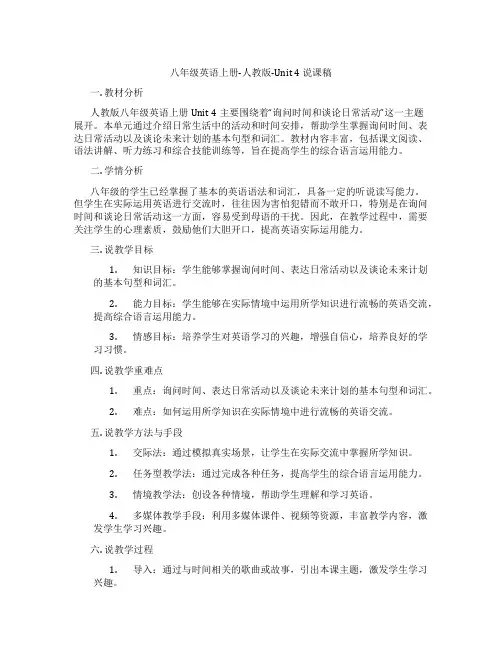
八年级英语上册-人教版-Unit 4 说课稿一. 教材分析人教版八年级英语上册Unit 4主要围绕着“询问时间和谈论日常活动”这一主题展开。
本单元通过介绍日常生活中的活动和时间安排,帮助学生掌握询问时间、表达日常活动以及谈论未来计划的基本句型和词汇。
教材内容丰富,包括课文阅读、语法讲解、听力练习和综合技能训练等,旨在提高学生的综合语言运用能力。
二. 学情分析八年级的学生已经掌握了基本的英语语法和词汇,具备一定的听说读写能力。
但学生在实际运用英语进行交流时,往往因为害怕犯错而不敢开口,特别是在询问时间和谈论日常活动这一方面,容易受到母语的干扰。
因此,在教学过程中,需要关注学生的心理素质,鼓励他们大胆开口,提高英语实际运用能力。
三. 说教学目标1.知识目标:学生能够掌握询问时间、表达日常活动以及谈论未来计划的基本句型和词汇。
2.能力目标:学生能够在实际情境中运用所学知识进行流畅的英语交流,提高综合语言运用能力。
3.情感目标:培养学生对英语学习的兴趣,增强自信心,培养良好的学习习惯。
四. 说教学重难点1.重点:询问时间、表达日常活动以及谈论未来计划的基本句型和词汇。
2.难点:如何运用所学知识在实际情境中进行流畅的英语交流。
五. 说教学方法与手段1.交际法:通过模拟真实场景,让学生在实际交流中掌握所学知识。
2.任务型教学法:通过完成各种任务,提高学生的综合语言运用能力。
3.情境教学法:创设各种情境,帮助学生理解和学习英语。
4.多媒体教学手段:利用多媒体课件、视频等资源,丰富教学内容,激发学生学习兴趣。
六. 说教学过程1.导入:通过与时间相关的歌曲或故事,引出本课主题,激发学生学习兴趣。
2.新课呈现:介绍本课的基本句型和词汇,通过图片、实物等辅助手段,帮助学生理解和记忆。
3.实践环节:模拟真实场景,让学生在实际交流中运用所学知识。
4.听力训练:播放与本课主题相关的听力材料,提高学生的听力技能。
5.综合技能训练:通过完成各种任务,提高学生的综合语言运用能力。
初二英语说课稿范文5篇
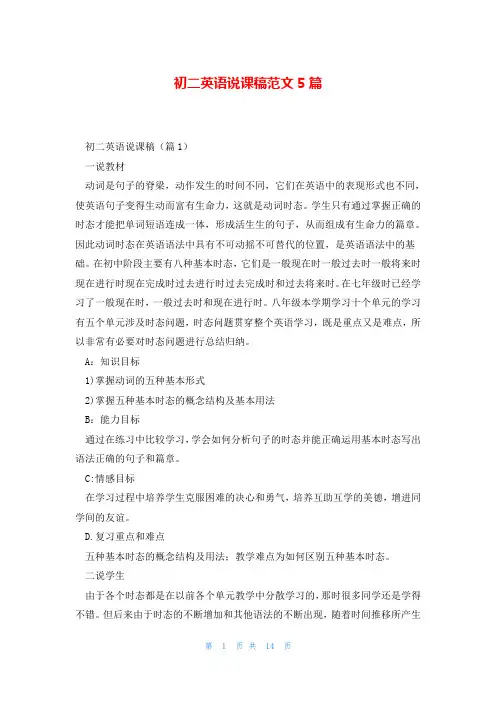
初二英语说课稿范文5篇初二英语说课稿(篇1)一说教材动词是句子的脊梁,动作发生的时间不同,它们在英语中的表现形式也不同,使英语句子变得生动而富有生命力,这就是动词时态。
学生只有通过掌握正确的时态才能把单词短语连成一体,形成活生生的句子,从而组成有生命力的篇章。
因此动词时态在英语语法中具有不可动摇不可替代的位置,是英语语法中的基础。
在初中阶段主要有八种基本时态,它们是一般现在时一般过去时一般将来时现在进行时现在完成时过去进行时过去完成时和过去将来时。
在七年级时已经学习了一般现在时,一般过去时和现在进行时。
八年级本学期学习十个单元的学习有五个单元涉及时态问题,时态问题贯穿整个英语学习,既是重点又是难点,所以非常有必要对时态问题进行总结归纳。
A:知识目标1)掌握动词的五种基本形式2)掌握五种基本时态的概念结构及基本用法B:能力目标通过在练习中比较学习,学会如何分析句子的时态并能正确运用基本时态写出语法正确的句子和篇章。
C:情感目标在学习过程中培养学生克服困难的决心和勇气,培养互助互学的美德,增进同学间的友谊。
D.复习重点和难点五种基本时态的概念结构及用法;教学难点为如何区别五种基本时态。
二说学生由于各个时态都是在以前各个单元教学中分散学习的,那时很多同学还是学得不错。
但后来由于时态的不断增加和其他语法的不断出现,随着时间推移所产生的遗忘,使学生对各种时态产生了混淆,主要是时态名称和结构容易张冠李戴。
那麽怎样使学生对基本时态清清楚楚,通过复习对学生进行查漏补缺,巩固提高,让他们准确得掌握时态。
三说教法要求学生在“用中学,学中用”,复习课的任务是梳理知识,查漏补缺,巩固提高。
所以在教学程序上充分利用准备好的复习资料,由浅入深,步步深入;在教学方式上以练为主线,让学生在练中分析,练中比较,练中探究,练中互助,练中提高;通过练习由混乱变清晰,由糊涂变明白,由理解到运用。
四说学法学生是学习的主体,个体差异各不相同。
初中英语外研社版八年级说课稿(通用6篇)
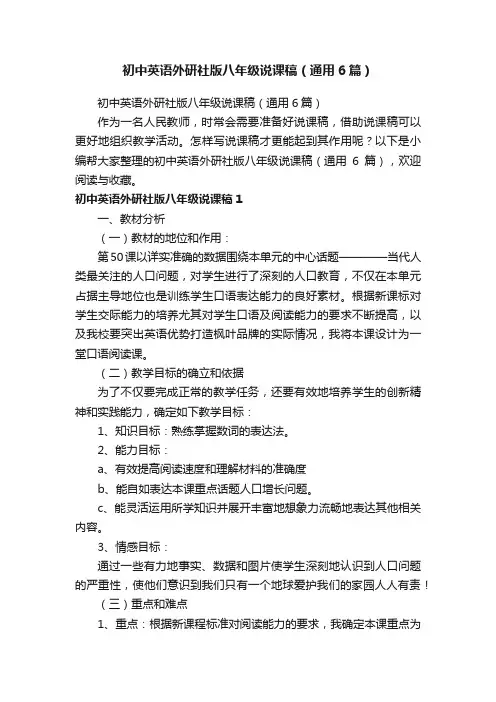
初中英语外研社版八年级说课稿(通用6篇)初中英语外研社版八年级说课稿(通用6篇)作为一名人民教师,时常会需要准备好说课稿,借助说课稿可以更好地组织教学活动。
怎样写说课稿才更能起到其作用呢?以下是小编帮大家整理的初中英语外研社版八年级说课稿(通用6篇),欢迎阅读与收藏。
初中英语外研社版八年级说课稿1一、教材分析(一)教材的地位和作用:第50课以详实准确的数据围绕本单元的中心话题————当代人类最关注的人口问题,对学生进行了深刻的人口教育,不仅在本单元占据主导地位也是训练学生口语表达能力的良好素材。
根据新课标对学生交际能力的培养尤其对学生口语及阅读能力的要求不断提高,以及我校要突出英语优势打造枫叶品牌的实际情况,我将本课设计为一堂口语阅读课。
(二)教学目标的确立和依据为了不仅要完成正常的教学任务,还要有效地培养学生的创新精神和实践能力,确定如下教学目标:1、知识目标:熟练掌握数词的表达法。
2、能力目标:a、有效提高阅读速度和理解材料的准确度b、能自如表达本课重点话题人口增长问题。
c、能灵活运用所学知识并展开丰富地想象力流畅地表达其他相关内容。
3、情感目标:通过一些有力地事实、数据和图片使学生深刻地认识到人口问题的严重性,使他们意识到我们只有一个地球爱护我们的家园人人有责!(三)重点和难点1、重点:根据新课程标准对阅读能力的要求,我确定本课重点为提高学生快速阅读的水平。
我采用英语趣味i教学法,采取图片导入、方法解析和逐步检验的方法使其掌握快速阅读的技巧。
2、难点:口语水平的提高。
我班的学生都来自公立学校,长期以来,传统的外语教学注重书本知识的讲授,忽视交际能力的培养使许多学生不敢开口、羞于在人前表达因而口语薄弱。
我通过创设引人入胜的情境和师生共同讨论、记者采访专家等新颖方式,以及不断鼓励的方法突破难点。
二、教学环节的设计学生具有无限的潜力,需要教师适时、适当地引导。
本节课中我尤其侧重训练学生通过合作探索来获取知识的过程,并注重改变学生以往的学习方式,通过设计有效问题激发学生的兴趣使他们始终处于主动寻求知识去学习而不是被动地接受知识的状态。
初中英语说课稿模板6篇
初中英语说课稿模板6篇初中英语说课稿模板6篇通过编写和使用教案,教师能够更好地实现教学目标,提高学生的学习效果和综合素质。
下面是小编为大家整理的初中英语说课稿模板,如果大家喜欢可以分享给身边的朋友。
初中英语说课稿模板【篇1】各位评委老师:下午好!今天我说课的内容是《牛津初中英语》8A Unit 2 School Life的Reading 第一课时。
对于这节课我将以教什么、怎么教、为什么这么教为思路,从教材分析、教法分析、学法分析和教学过程四个方面加以说明。
一、说教材本课以school lives为话题,以学习life in a British school and in an American school为载体,以find out the differences between a British school and an American school为任务。
为了使学生对这一话题更感兴趣,在教学过程中,我准备采用多媒体辅助教学这一教学模式设置情境,有效地将单词、句子和情景相结合,达到语言点的灵活运用和学生学以致用的目的。
教学目标:能听懂,会说,会读,会拼写单词mixed,subject,sew,tasty,hero,close,taste and article。
能根据关键词和上下语境猜测课文大意。
重难点:本课是Reading的第一课时,主要为了完成这样一个任务,即通过阅读理解文章主题,通过设计一些如true or false questions,answer questions,fill in the blanks,line the words等练习题检查学生对课文的理解程度。
由于新课程标准要求大力培养学生的阅读能力,所以通过阅读理解文章大意就成了本课的重点。
通过对文章的理解要求学生能用自己的语言描述出相关内容,这就是本课的难点。
二、说教法1.直观情境教学法:本课将利用多媒体创设情境,激发学生的好奇心和求知欲;设置语境,使学生体验语言的真实、自然,从而培养学生组织和表达语言的能力。
八年级英语说课稿7篇
八年级英语说课稿八年级英语说课稿7篇作为一位杰出的老师,时常需要编写说课稿,说课稿有助于提高教师的语言表达能力。
快来参考说课稿是怎么写的吧!以下是小编为大家整理的八年级英语说课稿,欢迎阅读,希望大家能够喜欢。
八年级英语说课稿1一、教材分析Would you mind keeping your voice down? 是(中国)课程教材研究所、英语课程教材研究中心与(美国)汤姆森学习出版集团合编的九年级义务教育课程标准实验教科书英语新目标Go for it ! Students,Book 八年级下册Unit7的一篇阅读课文。
是对整个单元的升华。
在前几节课中学生学习了用Would you mind??有礼貌地对别人发出请求.。
本节课通过文章进一步加深对有礼貌请求的句式的理解和在生活中的具体运用。
同时通过对中西方礼节的对比和描述,使同学们认识到礼节在日常生活中的重要性。
千万不要忘记“有礼貌地发出请求”。
进一步提高学生听、说、读、写的综合素质能力。
本节课主要是通过“以学生为中心,教师为辅导”的教学原则(Learner -centered , teacher –assisted ),通过任务型教学( task-based learning )创造性地使用英语。
在“学中用,用中学”,从而培养学生的文明礼仪,以礼待人的优良品质。
通过对本节课的学习后,学生会自然而然地感到英语学习并非是空中楼阁,而是实实在在可以用他来提高我们的自身素质,增强我们交际能力的科目。
二、教学对象分析初中二年级学生有了一定的英语知识,求知欲也很强。
所以本节课采用“把课堂还给学生”,“学生自学为主,教师为辅”的教学指导思想,并通过网络搜集到一些学生感兴趣的图画及动画材料。
这样学生的学习兴趣会大大提高。
三、教学目标分析(一)语言技能目标1、能连贯流畅地朗读课文。
2、能从文章中找出有关信息,理解大意。
(二)语言知识目标1、词汇(听、说、读、写)voice ,term ,Asian, Europe, ,impolite, allow, public ,cough, smoke ,drop ,litter, pick?up, behave2.语法理解“Would you mind doing?”的基本形式和表意功能。
初二英语说课稿(精选5篇)
初二英语说课稿(精选5篇)初二英语说课稿(精选5篇)所谓说课,就是教师备课之后讲课之前(或者在讲课之后)把教材、教法、学法、授课程序等方面的思路、教学设计、下面是我给大家整理的初二英语说课稿,希望能给大家带来帮助。
初二英语说课稿(精选篇1)一、说教材1、教材的地位和作用在单元第10课是一篇题为“MAKF OUR WORLD MORE BEAUTIFUL 的阅读教材,通过对环境保护这一话题的叙述增强学生环境保护的意识,懂得如何在日常生活中保护环境,文中主要运用现在完成时态的句子,其中也穿插了一般现在时和过去时,学生在特定的语境中感觉和发现英语时态的变化,从而达到正确运用英语的时态能力。
2、教学目的教学大纲指出要从英语的学科的特点出发,激发培养学生的兴趣,帮助学生树立学习英语的信心,克服学习中产生的畏惧心理和困难,建立语感,掌握语言基本知识和技能。
(1)知识目标这一课的知识目标很明确,就是围绕“环境保护”这一话题,继续学习和巩固现在完成时态的用法,利用本课所学习的话题,把功能与语法教学紧密结合一起。
(2)能力目标本课首先利用课前问题(pre-reading questions ),启发学生利用已有的知识经验,对课文内容进行预测,就有关话题开展讨论,通过阅读验证自己的推测,吸取信息,掌握新的知识,丰富经验,从而达到独立阅读的能力。
3、教材的重点、难点、关键(1)重点:本课重点在其运用完成时态的句子谈论环保这一话题。
(2)难点:对课文内容及时态含义的理解。
(3)关键:在于是否能突破难关,达到正确运用完成时态表达句意、理解全文的目标。
初二英语说课稿(精选篇2)一、说教材(一)、教材的地位和作用本单元以How do you get to school?为中心话题,围绕交通方式而展开,主要运用How long/How far 询问“去某地的交通方式、时间、距离。
”简单描述路线。
这一话题贴近学生们的日常生活,它继第三单元谈论“假日计划”后安排这样一个话题,符合学生的认知结构和年龄特征,它将为后几个单元的学习打下坚定的语言基础。
八年级英语上册说课稿(通用6篇)
八年级英语上册说课稿八年级英语上册说课稿(通用6篇)作为一名无私奉献的老师,通常会被要求编写说课稿,借助说课稿可以更好地提高教师理论素养和驾驭教材的能力。
我们该怎么去写说课稿呢?下面是小编帮大家整理的八年级英语上册说课稿,供大家参考借鉴,希望可以帮助到有需要的朋友。
八年级英语上册说课稿篇1一、说教材(一)教材的地位和作用:本节课是人教版八年级上册第六单元I’m going to study computer science的第一课时。
这一个单元在本册教材中占有重要的地位。
本单元的中心话题是谈论自己与他人的理想职业及未来打算。
首次接触“be going to” 结构,了解将来时态。
(二)教学目标:1、知识与技能:在这一节课中需要让学生能够掌握本节课所学的重点单词和句型,掌握一些与职业有关的单词,学会运用want to be… 和be going to… 结构来做句子和对话。
2、过程及方法;3、情感态度和价值观,通过对理想工作的了解和认识,使学生认识到只要坚持自己的梦想并为之努力,你的梦想就会实现。
(三)重难点:本节课的重难点主要是让学生掌握两个短语want to be … 和 be going to … 并能够运用这两个短语进行对话练习。
二、说学情由于本节课的教学对象是八年级的学生,相对于七年级学生有了一定的英语基础。
在单词记忆和句子掌握上有了一定的方法。
但是为了保证本节课的成功,还需要先提问那些勇于举手发言和英语水平相对较高的学生们,让其他的学生们能够明白和了解我所提问的内容,并给与他们充足的思考时间和自信心。
三、说教法在本节课中,我将授课、PPT演示与学案相结合,做到精讲,多练。
同时,将自己的角色定位在不仅仅是知识的传授者,同时也是课堂的主导,主要让学生做主人,提高学生自主学习的能力和小组合作的意识。
四、说学法引导学生通过猜测、观察等方法逐渐感悟新语言项目的功能,让学生在多层次的练习中体会到学习英语时“运用”的必要性,鼓励学生积极思维,大胆尝试。
- 1、下载文档前请自行甄别文档内容的完整性,平台不提供额外的编辑、内容补充、找答案等附加服务。
- 2、"仅部分预览"的文档,不可在线预览部分如存在完整性等问题,可反馈申请退款(可完整预览的文档不适用该条件!)。
- 3、如文档侵犯您的权益,请联系客服反馈,我们会尽快为您处理(人工客服工作时间:9:00-18:30)。
新修订初中阶段原创精品配套教材初中八年级英语说课稿教材定制 / 提高课堂效率 /内容可修改The junior middle school English speaking textbook教师:风老师风顺第二中学编订:FoonShion教育初中八年级英语说课稿一、教材分析1.教材的地位及作用:本单元围绕谈论过去的经历,学习使用现在完成时态。
通过对学生们喜闻乐见的一些娱乐场所(fun places)的描述,反复运用句型Have you ever been to…? I’ve never been to…. 来激发他们使用本单元所学单词的兴趣。
教材中提供的所有活动都以现在完成时态为中心,通过一系列的听、说、读、写的训练,来加深对现在完成时态的理解,明白英汉两种在结构及表达方法的一些异同点。
从而提高他们运用所学语言的综合能力。
2.教材的结构本单元分Section A 和Section B 两部分。
Section A 中通过所设计的各项任务呈现了两篇听力课文和一篇阅读理解。
Section B则安排了一篇听力和两篇小短文,用以加强对目标语言的理解。
Self Check 部分是用来检查学生对本单元所学目标语言的综合运用能力。
单元后的语篇训练旨在通过目标语言培养学生的阅读理解能力,掌握一些基本的阅读技巧。
3.教学目标(知识目标、能力目标、情感目标)1)知识目标:学习单词:Section Aspace museum, amusement park, aquarium, boat, water park, theme park, neither;Section BEnglish-speaking country, language, flight attendant, tour guide, used, improve;Self Checkunderstand, decide, rent, show, special掌握句型:Section AHave you ever been to an amusement park?Yes, I have. / No, I haven’t.I’ve never been to a water park.Me neither. / Me too. / So have I.Section BI want to understand English language movies.I want to study in an English-speaking country.It’s fun to learn another language.I have to.I want to travel.2)能力目标:训练学生运用所学知识进行听、说、读、写的综合能力。
3)情感目标:引导学生学会与别人分享快乐,发现身边的美好事物,从而树立正确的人生观和价值观。
培养学生学习英语的强烈兴趣,意识到合作学习的重要性。
4.重点和难点重点:1)掌握本单元的目标语言Have you ever been to…? / I’ve never been to….2) 记忆本单元的主要单词。
难点:1)比较现在完成时态与一般过去时态的异同。
2)听力课文中关键单词、短语及句子的理解。
3)帮助学生掌握阅读课文中的难句。
二、说教法在课堂教学中建立平等、民主、和谐的师生关系;切实转变教师的教学方式、学生的学习方式以及教学内容的呈现方式;重视师生互动、倡导合作学习;加强信息技术与学科课程的整合,运用多媒体教学手段辅助教学,注重实现教学方法的优化组合。
1.任务型教学法:这是新课标所倡导的新的教学理念,引导学生在完成任务的过程中“用中学,学中用”。
例如,将Self Check中的表格整合到第一课时中,完成1c后要求学生在小组内进行调查,培养学生运用目标语言解决实际问题的能力。
2.情景教学法:在课堂教学中,借助多媒体手段呈现一些图片、动画及资料,创设生动直观的教学情景,激发学生的学习兴趣。
3.合作探究法:例如在Section B中,围绕Why do you study English?组织学生共同探讨,鼓励学生们给出各自不同的答案,总结出学英语的重要性。
4.新旧知识对比法:在语法教学中采用传统的问答方式,让学生体味一般过去时与现在完成时的异同,从而进一步加深对目标语言的理解。
三、说学法学生是学习的主体,教学中要加强学法指导,让学生学会学习,关键是转变学生的学习方式,让学生成为学习的主人。
1.预习法:课前安排学生阅读教材内容,找出重难点,提出问题。
并带一些去各地游玩的照片,利用身边的有效资源来加深对目标语言的理解。
2.合作法:通过分组练习,使得人人开口说英语,用英语,培养他们积极参与,善于合作的团队精神。
3.角色表演法:例如在Section B中,设计一次互相采访,让学生在具体的语境中体味目标语言的真实性。
四、说流程1.总体设计及课时分配:1)Section A涉及两篇听力课文及一篇阅读理解。
按先输入,再输出的原则,以Have you ever been to …? / I’ve never been to. …为知识中心设计一系列听、说、读、写的任务,由浅入深,由易到难,谈论学生喜闻乐见的一些娱乐场所,使学生学会运用现在完成时来谈论过去的经历。
计划3课时完成。
第一课时(1a-1c)以key vocabulary 和理解Present Perfect Tense 的结构为主来设计任务。
从单元的整体框架来看,这部分是一个介绍和导入部分,主要的目标语言及话题在这一部分呈现。
可采用以旧带新的方法来呈现现在完成时的结构。
所选材料来源于现实,为学生所熟悉,能引起学生的学习兴趣。
尤其是课本上所提供的问题及画面能强烈刺激学生的感官,调动起他们的求知欲。
第二课时(2a-2c)通过对上一课的回顾,以一幅城市的旅游地图开始设计任务。
以三小段听力谈话为中心,使得目标语言在这一部分得以延伸。
加之适当的语法总结和语言点的精讲,能使学生对Have you ever been to…? / I’ve never been to… .更加清楚。
将Pairwork部分设计成一任务能更有效的帮助学生理解目标语言。
第三课时(3a-4)这是一篇长课文“Have you ever been to Disneyland?”。
着眼点并不是对文中语言点的讲解,而在于整体掌握文章的结构及基本的写作手法。
可根据文章设计一系列问题,让学生通过合作,自主去寻找、发现答案。
通过组织Pairwork和Groupwork来传授目标语言在语篇中的运用。
2)Section B包括一篇听力和两篇短文。
设计一次采访任务的角色表演和小组合作学习探讨的模式,从而加深学生对现在完成时在具体真实语境中的理解。
拟2课时教完。
第四课时(1a-2c)第一部分以Why do you study English?为话题,鼓励学生给出不同的有趣答案,充分调动课堂学习气氛。
而第二部分的听力,让学生捕捉目标语言在真实语境中的具体运用,以及与其它时态的对比。
拟用Pairwork来设计一次采访任务,这对学生则充满着挑战。
可通过适当的引导,给出问题,化难为易。
第五课时(3a-4)有两篇短文。
重点应放在使用目标语言的写作能力训练上。
3a可设计成限时阅读竞答,把学生分成几大组来抢答课文中的8个问题。
然后通过多媒体适当呈现文章中的一些重、难点,强化记忆。
可将4调到3b-3c之前为3b-3c的写作扫清一些障碍。
该写作练习有点难,但可以帮助学生养成即时使用目标语言及词汇写作的习惯。
3)淡化语法不等于不讲语法,所以在Self Check中设计成一堂语法与写作课,比较现在完成时与一般过去时的异同,通过练习进一步巩固学生对目标语言的理解和运用。
此为第六课时。
4)最后一篇阅读理解仍然以目标语言为话题,教会学生一些阅读策略。
1课时可完成。
2.教学过程设计:第一课时:1)导人:利用多媒体展示自己在一些地方游玩的照片,如长城、故宫、上海等,每次都提出Have you ever been to…? 引导学生集体回答Yes, I have./ No, I haven’t. I’ve never been to… 这样的热身活动可激发学生的学习兴趣,对即将要学的目标语言有个初步预知。
然后导入本单元课题,切入本堂课的三项任务:Remember Key words; Present Perfect Tense; Listening and Pairwork.2)Remember Key words 将课本中的娱乐场所剪切到屏幕上,通过看图、领读、齐读、背诵、默写,给学生形成强烈的感官刺激,强记本节课的关键单词和短语,为后面的两项活动做好铺垫。
3)Present Perfect Tense 展示现在完成时的基本结构,学生在第六单元已经学习了现在完成进行时,所以对所给出的现在完成时应不太陌生,通过几幅图片的展示及例句的讲解,使之明白可以使用现在完成时来谈论过去的经历。
为后面的Listening and Pairwork扫清语言结够上的障碍。
4)Listening 播放听力前要求学生对课本图画上的对话进行朗读与强记,化解了听力中的难点。
这时再播放两遍听力,一遍听,二遍做,完成1b已变得十分轻松了。
这同时也为接下来的Pairwork所需语言结构提供了模式。
5)Pairwork 将活动1中的图片调出反复播放,按1c要求做Pairwork. 此时教师可深入学生当中,解决他们交流中的一些实际问题。
然后请几组学生按展示的图片进行Role Play。
该活动的目的是从口语和听力上再次强化了学生对本单元目标语言的理解。
6)Make a Survey 将Self Check中的表格整合到这节课,考察学生运用目标语言解决实际问题的能力。
7)小结与作业调出屏幕上本节课的三项活动图片,总结本堂课内容,强调重难点,使学生对本堂课的知识线有个总体的掌握。
布置复习与预习的作业,要求他们下节课带到各地游玩的照片,为下节课的活动做好准备。
FoonShion教育研究中心编制Prepared by foonshion Education Research Center。
